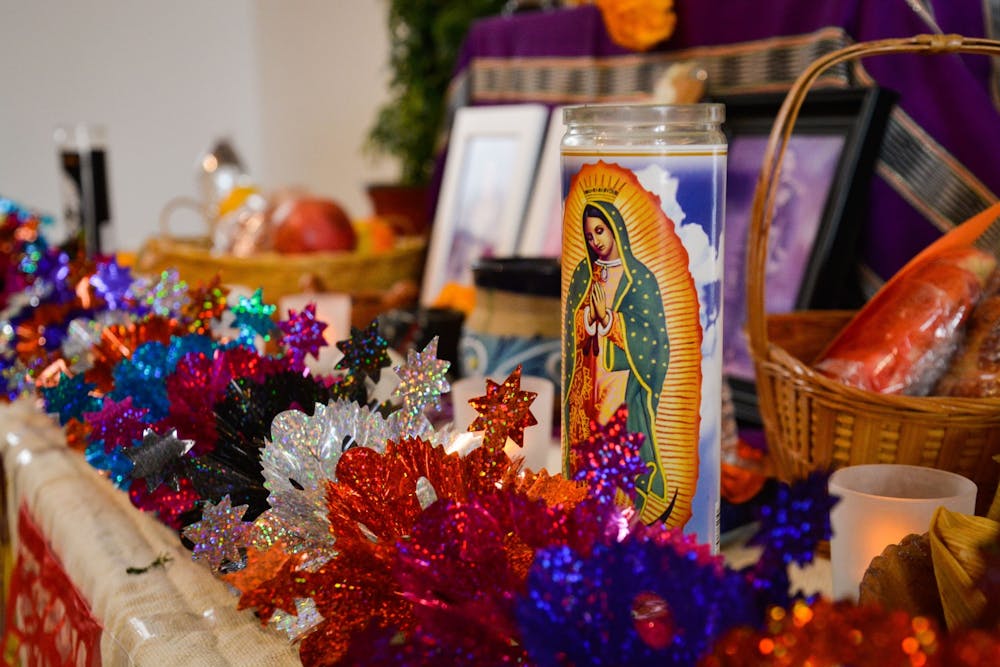The Mexican folk song "La Llorona" fades in as the smell of chocolate caliente fills the air. Women in long traditional skirts walk onto the stage as spectators of every age and color gathered around to watch the ballet. Spanish and English can be heard flowing, mixing, and overlapping as people gather around altars and other cultural stations, talking and laughing. The sense of shared heritage and community is almost tangible.
Día de los Muertos, or Day of the Dead, is a traditional Mexican holiday. The custom involves setting up ofrendas, or altars, to commemorate relatives who have passed, adorning them with marigold flowers, tissue paper decorations, and the foods, beverages, and toys that the deceased enjoyed while they were alive. This year, the holiday runs from Oct. 31 to Nov. 2. On Saturday, the Penn Museum hosted an event to commemorate the festival, in collaboration with the Mexican Cultural Center and the Mexican consulate in Philadelphia.
Hosted in the museum’s Egypt Upper Gallery, the event featured vendors selling traditional Mexican handicrafts, a stand serving Pan de Muerto—the “bread of the dead”—and hot chocolate, a stage for dancing and storytelling, stations for face–painting and coloring, various community altars, and an extremely intricate central altar. This centerpiece was beautiful and commanding. It grabbed the attention of passersby with its vibrant flowers and striking indigenous designs. On first view, the piece is almost overwhelming. But once you take a closer look, the beauty of every individual, deliberate component is revealed. In addition to the attractive visual aspect of the altar, it included labels that commemorated some 65 indigenous languages spoken in Mexico, emphasizing the diversity of people who celebrate this holiday.

“So the idea today…was to disseminate [the culture] as much as we could,” said Araceli Guenther, president of the Mexican Cultural Center. “It’s very rewarding for me because I see all the children…the looks on their faces when they see this or talk about this. It’s fantastic.”
The center works closely with the Consulate of Mexico to promote the country’s customs here in Philadelphia. Earlier this year, their Mexican independence day event at Penn’s Landing attracted some 20,000 attendees. For this event, the Cultural Center collaborated with the University’s museum, which Guenther describes as a “great partner.”
Despite being smaller than the Independence Day event, the appreciation for culture was certainly strong at this festival, too. Dances like the “Folkloric Ballet” performed by the Yaretzi Dance Group captivated the audience. Young children stared wide–eyed as women in full calavera costumes strolled around the space stoically. Adults chatted over hot chocolate and Pan de Muerto, perusing the vendors’ tables or listening to presentations. Community members stood by their altars, welcoming attendees to engage with them, ask questions, and learn about the tradition.

Because the altars were personal, and unique to the families of the community members, viewing these arrangements is a very intimate experience—even for visitors like myself who don’t personally celebrate the holiday. Images of people’s parents, grandparents, and other lost loved ones rested elegantly on the altar shelves, trinkets and beers placed casually by their sides.
One of the community members sharing her altar was Maria Felix. Born in Guerrero, Mexico, she has now lived in Pennsylvania for almost two decades. For Felix, Día de los Muertos has always been a part of her life. She remembers her mother arranging the altar throughout her childhood, and keeps up the tradition for the sake of passing it on to her children. “It’s important for me for my kids to keep the culture alive,” she said. “I’ve been hoping that when I die, they’ll remember me and…I don’t know, that’s our belief. That we come back.”

Felix’s altar was adorned with the traditional marigold flowers—called cempasuchil in Mexico—as well as candles, tissue paper decorations, and the “food…toys…and beer” enjoyed by her relatives during their lives. She explains that “because [the marigold] is really bright and yellow, the souls know where we’re at. And we put the candles because we believe that when they go back, they can take the light…and guide their way back to where they are resting.” Felix grows her own cempasuchil flowers for the altar every year, and donates the rest to her local church.
Felix was just one of many community members who displayed altars this past weekend. All were passionate about sharing their love for their relatives. It was incredibly humanizing to see them cheerfully commemorated like this—brought back to life, almost, if just for a few days.
The Día de los Muertos celebration continues through Nov. 2 this year. Through a host of rich traditions, Mexican families will be celebrating the return of their departed loved ones this week. And even if you aren’t Mexican, this tradition is a reminder of the value of positive remembrance.







